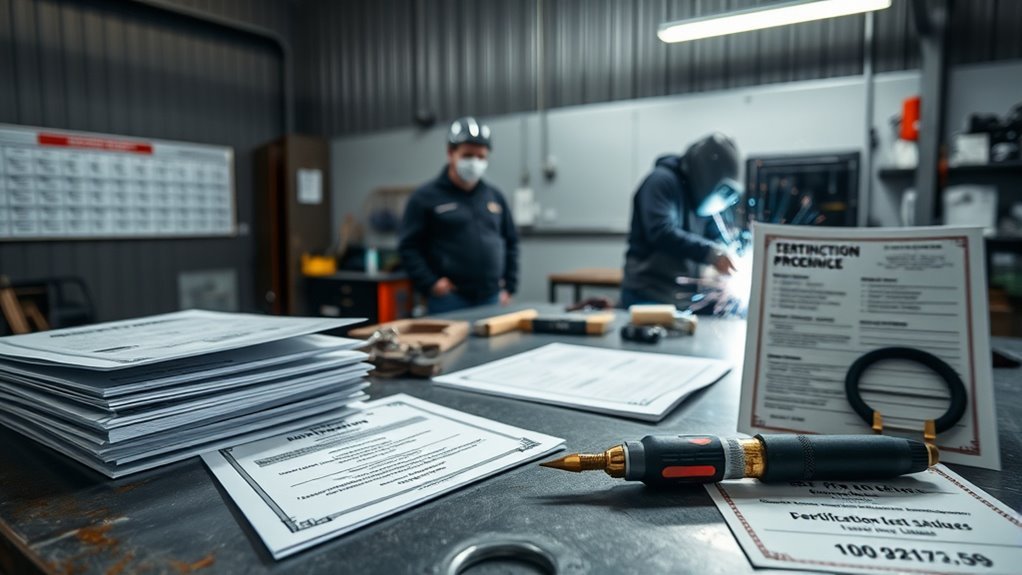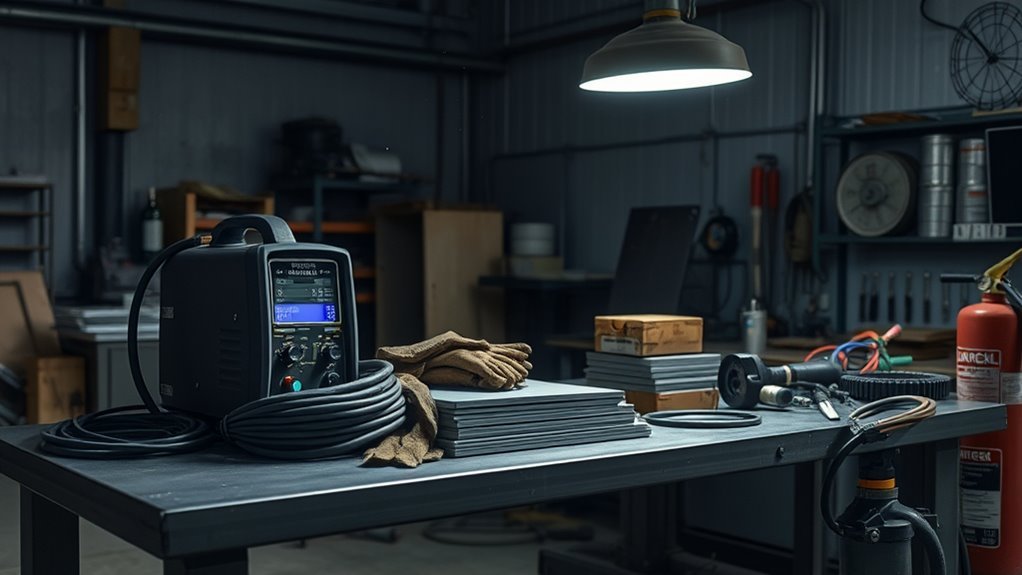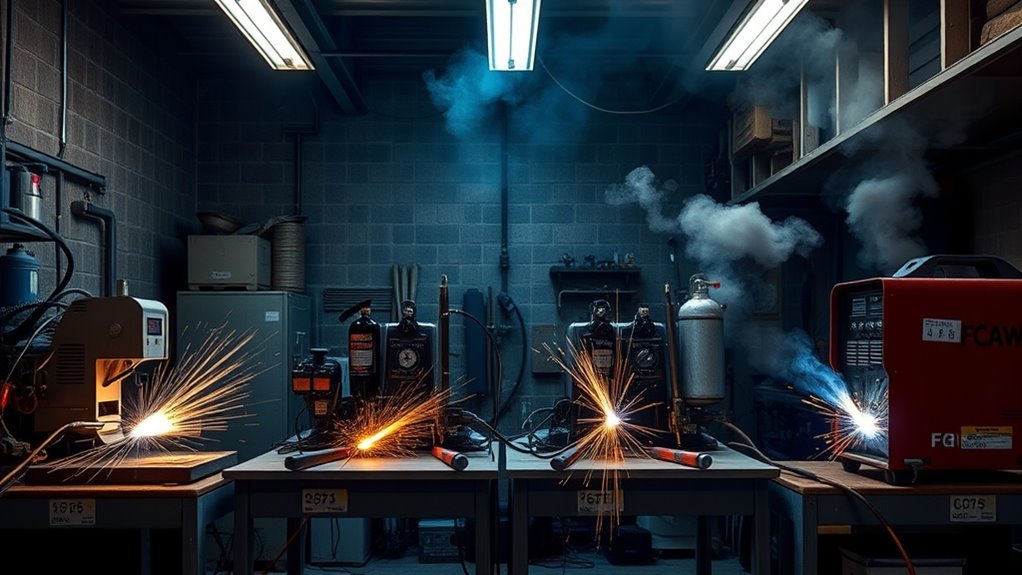If you’re planning to get coded in welding, expect to pay anywhere from a few hundred for a single weld test to several thousand for a full program, depending on process, level, and location. Certification fees, facility use, and instructor time are usually itemized, while PPE, tools, and consumables add more. You’ll want to compare what’s actually included in the price before you commit — and there are cost traps to watch for.
Typical Price Range for Coded Welding Programs

You’ll typically pay between $5,000 and $30,000 for a coded welding program, with price driven by program length, type, and location.
You should budget according to program duration: courses run from a single-day intensive to multiweek programs up to six weeks, and longer, more complex curricula command higher fees.
Budget by program length: from single-day intensives to multiweek courses — longer, more complex curricula cost more.
Location factors also affect cost—urban training centers and regions with higher living costs list steeper tuition and facility charges.
You’ll encounter additional line-item expenses: exam fees for certifications such as AWS D1.1 (about $460 without ATF), retest fees per position typically $120–$250, and consumables or tooling if not provided.
Many schools publish fee schedules and offer financing or scholarships; you should request an itemized quote and confirm whether certification exams and materials are included.
For precise budgeting, compare program duration, certification inclusions, and location factors to match standards-focused training with your certification goals.
What’s Included in Certification Fees

When you pay for a welding certification test, the fee usually covers required test materials and consumables—electrodes, plates, backing, and any filler metal specified by the code.
You’ll also be charged for paperwork and registry services if you opt for the AWS ATF upgrade, which records your certification and issues an AWS card.
Be aware retest fees and differences between codes like AWS D1.1 and ASME IX can change the final amount.
Test Materials and Consumables
Although certification fees vary by code and test, they generally cover all required test materials and consumables—like welding rods, filler metals, and specimen blanks—specified by the governing standard for that particular qualification. You’ll find test material types and consumable selection are defined in the procedure; fees usually include initial and retest materials per that scope. Optional upgrades or registry entries can add cost, and you must supply personal PPE. Below is a concise breakdown of common inclusions.
| Item | Included | Notes |
|---|---|---|
| Welding rods | Yes | Specified alloy/diameter |
| Filler metal | Yes | Per procedure code |
| Specimen blanks | Yes | Dimensions per standard |
| PPE | No | Candidate responsibility |
Confirm scope with the testing authority before scheduling.
Registry and Paperwork Fees
Because certification isn’t just about passing a weld test, the fees also cover paperwork, registry entry, and administrative processing that officially document your qualification.
You’ll pay to meet paperwork requirements: test forms, examiner documentation, and submission of qualifying records.
Registry importance is reflected in fees that include entry into the AWS certified welder registry, which employers use to verify your scope, positions, and material thicknesses.
Typical certification fees range from $460 to $685 depending on the test and ATF upgrade (for example, $460 or $615 for 3/8″ V+OH; $520 or $685 for 1″ V+OH).
Retest fees, usually $120–$250 per position, also cover administrative handling.
Budget for these costs when planning to get coded; they’re part of the compliance trail.
Extra Costs to Budget For (PPE, Tools, Materials)

You’ll need to budget beyond tuition and testing for three main categories: personal protective equipment (gloves, safety glasses, welding hood—often $300+), an essential hand-tool kit (around $500, sometimes included by programs), and consumable materials (metals, electrodes, gas) that vary by process and projects.
Also plan for books and course materials ($200–$500) and certification testing fees ($460–$685 depending on code and ATF upgrades).
Itemize these costs up front so you can meet program safety and performance standards without surprises.
Personal Protective Equipment
When you train in welding, plan to buy personal protective equipment (PPE) and basic tools right away since most programs require your own gear for labs and practicals; expect gloves, safety glasses, and a welding hood to cost roughly $100–$300, while a basic tool kit typically runs $200–$500.
You’ll follow PPE standards and local safety regulations, so select gear that meets ANSI/ISEA, CSA, or relevant certs. Prioritize auto-darkening helmets with appropriate shade ranges, heat- and cut-resistant gloves, and impact-rated eyewear.
Inspect and replace damaged items before practicals to remain compliant. Budget these mandatory purchases as part of course costs: they protect you, improve weld quality, and are often enforced during assessments, so don’t skimp on certified equipment.
Essential Hand Tools
Although some programs supply basic kits, you should budget and plan for a set of essential hand tools that meet industry standards and the specific demands of your projects.
Expect PPE basics—gloves, safety glasses, a welding hood—to add $200–$500 depending on quality and brand; basic PPE sets often fall between $100–$300.
If your training includes a complimentary kit, treat it as baseline and identify missing items for specialty work.
Apply disciplined budgeting strategies: list required tools, verify industry specifications, and price-brand options to control costs.
Remember welding equipment beyond hand tools (fixtures, clamps, grinders) can increase expenses.
Plan for a combined outlay—tools, PPE, and materials—that may range from several hundred to over a thousand dollars.
Consumable Materials Cost
Because consumables directly affect both day-to-day training and final weld quality, budget them deliberately: expect an added $200–$500 for items like welding rods, filler wires, and shielding gases, with PPE costs around $100–$300 and basic hand tools typically $200–$1,000 depending on brand and specs.
You’ll want a line-item for welding rods, wires and gases ($50–$300) and PPE (gloves, hood, safety glasses) that meets program safety standards.
Use strict budgeting strategies: obtain required-material lists from your school, price-match suppliers, and buy quality PPE to reduce replacement frequency.
Track consumption rates per project to forecast reorder points.
Accurate consumable materials budgeting minimizes training interruptions and guarantees consistent weld qualification outcomes.
Differences by Welding Process: TIG, MIG, MMA, FCAW

If you need to choose among TIG, MIG, MMA, and FCAW, start by matching each process to the joint types, base metals, and code requirements you’ll encounter, since those factors drive both performance and certification costs.
TIG advantages include precision on thin stainless and aluminum but often require higher training time and specific position tests that push initial certification toward the upper cost range.
TIG offers precise control on thin stainless and aluminum but demands more training and stricter position tests, raising initial costs.
MIG applications suit production carbon-steel joints with faster deposition and typically standard AWS D1.1 tests.
MMA techniques remain essential for fieldwork and simple joint geometry, with modest test fees and common retest options.
FCAW benefits include high-deposition on thick sections and specific procedure qualification needs that can affect test selection.
- TIG advantages: thin, precise, stricter code fit-up
- MIG applications: production, common D1.1 testing
- MMA techniques: field versatility, lower prep
- FCAW benefits: high deposition, thick sections
- Cost notes: certifications $460–$685; ATF upgrades add fees
Short Courses vs. Extended Coding Programs

Wondering which route fits your project needs — a short coded course or an extended program? You’ll choose based on duration, standards, and scope.
Short courses typically run one day to six weeks and emphasize targeted technique and code application; short course benefits include lower cost, focused skills for TIG, MIG, or stick, and rapid qualification for specific tasks.
Extended programs span several months to cover ASME IX, ISO 9606, or BS 4872 requirements, deeper metallurgical theory, and multiple-process competency. Extended program advantages are thorough assessment, broader process coverage, and stronger alignment with complex industry specs.
You should weigh time-to-competency against long-term versatility: short courses get you producing sooner for limited-scope work, while extended training readies you for diverse coded inspections and rigorous certification paths.
Both paths issue certifications that typically require re-testing every two years to maintain validity and guarantee ongoing compliance with applicable welding standards.
How Retests and Upgrades Affect Total Cost

When you plan for coded welding certification, include retest and upgrade fees in your budget because a single failed position can add $120–$250 to your cost and multiple failures multiply that expense quickly.
You should calculate worst-case scenarios: an AWS D1.1 test is $460 and a retest typically runs $250 per position. If you choose ATF registration as an upgrade, add about $155, raising the D1.1 total to roughly $615.
Use retest strategies to minimize repeat attempts — targeted practice, mock tests, and addressing specific weld positions reduce cost exposure. Evaluate upgrade options only when they deliver measurable benefits (scheduling flexibility, standardized procedure control).
Use targeted practice, mock exams, and focus on weak positions to cut retests — upgrade only for clear benefits.
- Budget for at least one retest per position
- Prioritize practice on weakest positions
- Compare standard vs. ATF costs and benefits
- Track per-position failure rates before upgrading
- Schedule mock exams to lower retest risk
Plan precisely; small oversights in retest fees and upgrades inflate overall certification cost.
Financial Aid, Scholarships, and Veteran Benefits

After you’ve accounted for testing, retest, and upgrade costs, cover how you’ll actually pay for training: federal grants, low‑interest loans, institutional financing and scholarships can materially reduce out‑of‑pocket expenses for welding certification. You should evaluate financial aid options systematically: verify federal grant eligibility, compare loan terms, and review institutional financing schedules. MTI lists GI Bill® assistance for veterans and dependents; confirm enrollment certification and allowable expenses to guarantee full use of benefits. Scholarship eligibility often depends on grade level, program intent, and documentation — MTI, the American Welding Society, and other organizations publish specific criteria. Use the table below to track primary assistance sources and action steps.
| Source | Action |
|---|---|
| Federal grants | Apply via FAFSA; document program enrollment |
| Low‑interest loans | Compare APRs; request repayment terms |
| Scholarships | Check eligibility, deadlines on MTI and AWS sites |
| GI Bill®/Veteran benefits | Submit COE to MTI; verify tuition coverage |
Document approvals, deadlines, and disbursement timing to avoid gaps in funding.
Choosing a Cost-Effective Training Provider

Because training quality and total cost vary widely, you should prioritize providers that bundle tuition, fees, books, and essential tool kits and clearly list what’s included, so you can compare true out‑of‑pocket costs (MTI packages, for example, range roughly $5,000–$30,000 depending on scope).
Prioritize programs that transparently bundle tuition, fees, books, and essential tools to reveal true out‑of‑pocket costs.
Inspect program outlines, verify which certification options are offered, and confirm whether exam and retest fees are included. Ask about class size, hands‑on hours, and instructor qualifications tied to industry standards.
- Confirm bundled costs: tuition, fees, books, tools
- Verify available certification options (AWS, ASME)
- Check financial aid and scholarship participation
- Evaluate hands‑on hours and instructor-to-student ratio
- Clarify exam/retest inclusion and extra fees
You should favor providers delivering thorough training with documented competencies and clear pathways to certification.
Request syllabi, assessment methods, and pass‑rate data. Compare total billed cost against expected deliverables to select the most cost‑effective, standards-aligned program for coded welding certification.
Return on Investment: Salary Prospects and Career Paths

If you pursue coded welding certification like ASME IX or ISO 9606, you’ll increase your marketability and typically command higher starting pay—around £13–£16 per hour—with experienced, specialized welders earning substantially more depending on sector demand. You’ll see measurable salary growth as you gain endorsements and re-test every two years, which employers value for ensuring competence. Certification opens roles in oil & gas, construction, and manufacturing, improving job stability and promotion potential. You should view the certification cost as a controlled investment: upfront fees, retest cycles, and targeted training yield higher billable rates and preferential hiring.
| Immediate impact | Long-term outcome |
|---|---|
| Higher starting pay | Career advancement |
| Preferential hiring | Sustained salary growth |
| Access to specialized sectors | Enhanced job stability |
| Standardized validation | Repeatable requalification |
| Employer confidence | Market resilience |
Plan renewals and skill mapping to maximize return on investment and maintain standards compliance.
Frequently Asked Questions
Do Employers Cover Coding Costs or Reimburse Trainees?
Yes — many employers cover coding costs or reimburse trainees, but it depends on employer policies and training programs; you’ll need to review written agreements, eligibility requirements, repayment clauses, and certification standards before enrolling.
How Long Does a Certification Card Remain Valid?
“Measure twice, cut once.” Your certification card typically remains valid for one to five years depending on code authority; you’ll monitor expiration dates and follow certification renewal procedures to maintain standards and documented competency.
Are Online Theory Courses Accepted for Coded Weld Testing?
Generally no — you’ll need in-person performance tests; online welding courses may cover theory but often won’t guarantee certification acceptance. Check specific code bodies (ASME, AWS, ISO) for acceptable blended training and documented equivalency.
Can Foreign Welding Codes Be Transferred Domestically?
Yes — you can often transfer foreign welding codes domestically, but you’ll need documented code recognition, evidence of equivalence to local international standards, and formal approval from the authority having jurisdiction before certification is accepted.
What Insurance or Liability Coverage Is Required During Testing?
About 60% of labs require proof of insurance; you’ll need specific insurance requirements and liability coverage naming the test facility, covering at least bodily injury, property damage, and a professional indemnity limit per the applicable welding standard.
Conclusion
You’re investing in more than training — you’re buying a toolbox and a ticket into a skilled trade. Expect to pay roughly $5,000–$30,000 for coded welding, plus $460–$685 per certification and about $1,000 for PPE and tools. Short courses cost less upfront but give limited scope; extended programs and retests raise totals. Seek scholarships, VA benefits, or reputable providers to lower risk. Think of certification as a measured blueprint for a steady, well-paid career.


